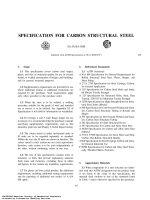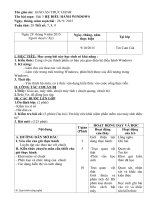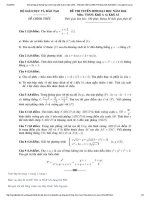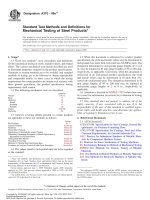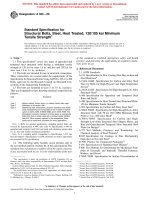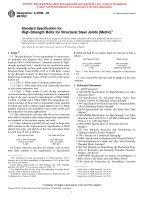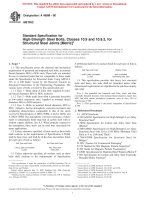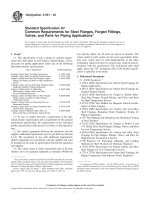Astm a 772 a 772m 00 (2016)
Bạn đang xem bản rút gọn của tài liệu. Xem và tải ngay bản đầy đủ của tài liệu tại đây (106.53 KB, 4 trang )
Designation: A772/A772M − 00 (Reapproved 2016)
Standard Test Method for
AC Magnetic Permeability of Materials Using Sinusoidal
Current1
This standard is issued under the fixed designation A772/A772M; the number immediately following the designation indicates the year
of original adoption or, in the case of revision, the year of last revision. A number in parentheses indicates the year of last reapproval.
A superscript epsilon (´) indicates an editorial change since the last revision or reapproval.
A340 Terminology of Symbols and Definitions Relating to
Magnetic Testing
1. Scope
1.1 This test method provides a means for determination of
the impedance permeability (µz) of ferromagnetic materials
under the condition of sinusoidal current (sinusoidal H) excitation. Test specimens in the form of laminated toroidal cores,
tape-wound toroidal cores, and link-type laminated cores
having uniform cross sections and closed flux paths (no air
gaps) are used. The method is intended as a means for
determining the magnetic performance of ferromagnetic strip
having a thickness less than or equal to 0.025 in. [0.635 mm].
3. Terminology
3.1 Definitions—The terms and symbols used in this test
method are defined in Terminology A340.
4. Significance and Use
4.1 The permeability determined by this method is the
impedance permeability. Impedance permeability is the ratio of
the peak value of flux density (Bmax) to the assumed peak
magnetic field strength (Hz) without regard to phase. As
compared to testing under sinusoidal flux (sinusoidal B)
conditions, the permeabilities determined by this method are
numerically lower since, for a given test signal frequency, the
rate of flux change (dB/dt) is higher.
1.2 This test method shall be used in conjunction with those
applicable paragraphs in Practice A34/A34M.
1.3 The values and equations stated in customary (cgs-emu
and inch-pound) or SI units are to be regarded separately as
standard. Within this standard, SI units are shown in brackets
except for the sections concerning calculations where there are
separate sections for the respective unit systems. The values
stated in each system may not be exact equivalents; therefore,
each system shall be used independently of the other. Combining values from the two systems may result in nonconformance
with this standard.
1.4 This standard does not purport to address all of the
safety concerns, if any, associated with its use. It is the
responsibility of the user of this standard to establish appropriate safety and health practices and determine the applicability of regulatory limitations prior to use.
4.2 This test method is suitable for impedance permeability
measurements at very low magnetic inductions at power
frequencies (50 to 60 Hz) to moderate inductions below the
point of maximum permeability of the material (the knee of the
magnetization curve) or until there is visible distortion of the
current waveform. The lower limit is a function of sample area,
secondary turns, and the sensitivity of the flux-reading voltmeter used. At higher inductions, measurements of flux-generated
voltages that are appreciably distorted mean that the flux has
appreciable harmonic frequency components. The upper limit
is given by the availability of pure sinusoidal current, which is
a function of the power source. In addition, a large ratio (≥10)
of the total series resistance of the primary circuit to the
primary coil impedance is required. With proper test apparatus,
this test method is suitable for use at frequencies up to 1 MHz.
2. Referenced Documents
2.1 ASTM Standards:2
A34/A34M Practice for Sampling and Procurement Testing
of Magnetic Materials
4.3 This test method is suitable for design, specification
acceptance, service evaluation, quality control, and research
use.
1
This test method is under the jurisdiction of ASTM Committee A06 on
Magnetic Properties and is the direct responsibility of Subcommittee A06.01 on Test
Methods.
Current edition approved April 1, 2016. Published April 2016. Originally
approved in 1980. Last previous edition approved in 2011 as A772/A772M – 00
(2011)ɛ1. DOI:10.1520/A0772_A0772M-00R16.
2
For referenced ASTM standards, visit the ASTM website, www.astm.org, or
contact ASTM Customer Service at For Annual Book of ASTM
Standards volume information, refer to the standard’s Document Summary page on
the ASTM website.
5. Apparatus
5.1 The test circuit, which is schematically illustrated in Fig.
1, shall consist of the following components.
5.2 Power Supply—For power frequency (50- or 60-Hz)
testing, a suitable power supply consists of two or three series
connected autotransformers of sufficient power rating. This
Copyright © ASTM International, 100 Barr Harbor Drive, PO Box C700, West Conshohocken, PA 19428-2959. United States
1
A772/A772M − 00 (2016)
equations in 7.1 and 7.2 or 8.1 and 8.2. To obtain acceptable
uniformity of magnetic field strength throughout the specimen,
the following dimensional constraints shall be observed:
(1) for a toroid the inside diameter to outside diameter ratio
shall exceed 0.82, and
(2) for the link specimen shown in Fig. 2, the separation (s)
shall exceed nine times the radial width (w).
6.1.2 A secondary winding (N2) using insulated wire shall
be uniformly distributed over the test specimen using a
sufficient number of turns so that a measurable voltage will be
obtained at the lowest flux density of interest. A uniformly
distributed primary winding (N1) of insulated wire shall be
applied on top of the secondary winding and be of sufficient
diameter to conduct the highest intended magnetizing current
safely without significant heating. Twisted leads or biconductor
cable shall be used to connect the specimen windings to the test
apparatus.
FIG. 1 Schematic Circuit for Sinusoidal Current Permeability Test
will provide a continuously variable current source to excite
the test specimen. For testing at other than power frequency, an
ac power source consisting of a low distortion sinusoidal signal
generator and linear amplifier are required. The use of feedback
control of the power amplifier is permitted.
5.3 Isolation/Stepdown Transformer—The use of a low
distortion isolation/stepdown transformer is highly recommended for operator safety and to eliminate any dc bias current
present when using electronic power supplies. A combined
isolation/stepdown transformer can provide greater control
when testing is done at very low magnetizing currents.
6.2 Calculation of Test Signals—Testing is done either at
specified values of flux density (Bmax) or magnetic field
strength (Hz). Before testing, the rms magnetizing currents or
voltages generated in the secondary shall be calculated using
the equations found in 7.3 and 7.4 or 8.3 and 8.4.
5.4 Primary Series Resistor (Z)—A noninductive resistor
having sufficiently high resistance to maintain sinusoidal current conditions at the highest magnetizing current and test
signal frequency of interest. In practice, resistance values of 10
to 100 Ω are used. If this resistor is used to measure the
magnetizing current, the resistance shall be known to better
than 0.5 % and the resistance shall not increase by more than
0.5 % at the rated maximum current of the power supply.
6.3 Demagnetization—After connecting the primary and
secondary windings to the apparatus, the test specimen shall be
demagnetized by applying a magnetizing current sufficiently
large to create a magnetic field strength greater than ten times
the coercivity of the test specimen. The magnetizing current
then shall be slowly and smoothly reduced to zero to demagnetize the test specimen. The frequency used should be the
same as the test frequency.
5.5 True RMS Ammeter (A)—A true rms ammeter or a
combination of a noninductive, precision current viewing
resistor and true rms voltmeter shall be used to measure the
magnetizing current. The meter shall have an accuracy of better
than 0.5 % full scale at the test frequency. The current viewing
resistor, if used, shall have an accuracy better than 0.5 % and
shall have sufficient power rating such that the resistance shall
not vary by more than 0.5 % at the rated maximum current of
the power supply.
6.4 Measurement—The magnetizing current shall be carefully increased until the lowest value of either magnetizing
current (if measuring at a specified value of magnetic field
strength) or flux density (if measuring at a specified value of
flux density) is obtained. Both the magnetizing current and
secondary voltage shall be recorded. The magnetizing current
is then increased to the next test point and the process repeated
until all test points have been measured. It is imperative that
measurements be made in order of increasing magnetic field
strength or flux density. When a prescribed value of magnetic
field strength or flux density has been accidentally exceeded
during the test, the specimen must be demagnetized and testing
resumed at that point.
5.6 Flux Measuring Voltmeter (V)—The flux shall be determined from the voltage induced in the secondary winding
using one of the following type of voltmeter:
(1) an average responding digital voltmeter calibrated to
read rms volts for a sine wave, or
(2) a true average responding digital voltmeter.
The voltmeter shall have input impedance greater than 1 MΩ,
a full-scale accuracy of better than 0.5 % at the test frequency,
and a crest factor capability of 3 or greater.
6. Procedure
6.1 Specimen Preparation—After determining the mass and
dimensions of the test specimen, it should be enclosed in a
suitable insulating case to prevent intimate contact between it
and the primary and secondary windings. This will also
minimize the stress introduced by winding. The case shape and
size shall approximate that of the test specimen so that the
secondary winding encloses minimal air flux. All test specimens shall have a uniform rectangular cross section.
6.1.1 The cross-sectional area and mean magnetic path
length of the test specimen shall be calculated using the
FIG. 2 Schematic of Link-Type Lamination
2
A772/A772M − 00 (2016)
6.4.1 At the conclusion of testing, the magnetizing current
shall be reduced to zero and the specimen removed from the
test apparatus. The impedance permeability shall be calculated
using the equations found in 7.5 or 8.5.
7.4.2 The peak flux density when using a true average
responding voltmeter is calculated as:
7. Calculation (Customary Units)
where:
Bmax = peak flux density (induction), gauss;
= flux voltage measured across secondary winding, V;
Ef
Eavg = average voltage measured across secondary winding,
V;
f
= test frequency, Hz;
= number of secondary turns; and
N2
A
= cross-sectional area of test specimen, cm2.
B max 5
7.1 Calculation of Mean Magnetic Path Length, l (assumed
to be equal to the mean geometric path):
7.1.1 For toroidal cores:
l5
π ~ D1d !
2
(1)
where:
l = mean magnetic path length, cm;
D = outside diameter, cm; and
d = inside diameter, cm.
µz 5
(2)
where:
l
= mean magnetic path length, cm;
L0 = total length, cm;
L = length of parallel sides, cm;
s = wall separation, cm; and
w = radial width, cm.
where:
A =
m =
l
=
δ
=
m
lδ
l5
(3)
l 5 2L1π ~ s1w ! 5 2L 0 1 ~ π 2 2 ! s1 ~ π 2 4 ! w
8.2 Calculation of Cross-Sectional Area, A
8.2.1 For either toroidal or link type cores, the crosssectional area is calculated from the mass and mean magnetic
path length as:
(4)
assumed peak magnetic field strength, Oe;
number of primary turns;
rms magnetizing current, A; and
mean magnetic path length of specimen, cm.
where:
A =
m =
l
=
δ
=
7.4 Calculation of Peak Flux Density, Bmax
7.4.1 The peak flux density when using an average responding voltmeter calibrated to yield rms values for a sine wave is
calculated as:
B max 5
=2πfN2 A
(9)
where:
l
= mean magnetic path length, m;
L0 = total length, m;
L = length of parallel sides, m;
s = wall separation, m; and
w = radial width, m.
A5
108 E f
(8)
8.1.2 For link cores of the form shown in Fig. 2:
7.3 Calculation of the Assumed Peak Magnetic Field
Strength, Hz—The assumed peak magnetic field strength is
calculated from the rms value of magnetizing current as:
where:
Hz =
N1 =
Im =
l
=
π ~ D1d !
2
where:
l = mean magnetic path length, m;
D = outside diameter, m; and
d = inside diameter, m.
Note that the core height or lamination stacking factor is not
required in the preceding equation.
0.4π =2N 1 I m
l
(7)
8.1 Calculation of Mean Magnetic Path Length, l (assumed
to be equal to the mean geometric path):
8.1.1 For toroidal cores:
cross-sectional area, cm2;
specimen mass, gm;
mean magnetic path length, cm; and
specimen density, g/cm3.
Hz 5
B max
Hz
8. Calculation (SI Units)
7.2 Calculation of Cross-Sectional Area, A:
7.2.1 For either toroidal or link-type cores, the crosssectional area is calculated from the mass and mean magnetic
path length as:
A5
(6)
7.5 Calculation of Impedance Permeability, µz
7.5.1 The impedance permeability is calculated as the ratio
of Bmax to Hz or:
7.1.2 For link cores of the form shown in Fig. 2:
l 5 2L1π ~ s1w ! 5 2L 0 1 ~ π 2 2 ! s1 ~ π 2 4 ! w
108 E avg
4fN2 A
m
lδ
(10)
cross-sectional area, m2;
specimen mass, kg;
mean magnetic path length, m; and
specimen density, kg/m3.
Note that the core height or lamination stacking factor is not
required in the preceding equation.
8.3 Calculation of the Assumed Peak Magnetic Field
Strength, Hz—The assumed peak magnetic field strength is
calculated from the rms value of magnetizing current as:
(5)
3
A772/A772M − 00 (2016)
Hz 5
=2N 1 I m
l
Eavg
(11)
f
N2
A
where:
Hz = assumed peak magnetic field strength, A/m;
N1 = number of primary turns;
lm = rms magnetizing current, A; and
l
= mean magnetic path length of specimen, m.
8.4 Calculation of Peak Flux Density, Bmax
8.4.1 The peak flux density when using an average responding voltmeter calibrated to yield rms values for a sine wave is
calculated as:
B max 5
Ef
=2πfN2 A
8.5 Calculation of Impedance Permeability, µz
8.5.1 In the SI system of units, the ratio of Bmax to Hz is the
absolute impedance permeability. A more useful form is the
relative impedance permeability which is the ratio of the
absolute permeability to the permeability of free space or:
µz 5
(12)
B max
B max
Γ mH z
(14)
Γm = magnetic constant equal to 4π × 10–7 H/m.
8.4.2 The peak flux density when using a true average
responding voltmeter is calculated as:
E avg
5
4fN2 A
= average voltage measured across secondary winding,
V;
= test frequency, Hz;
= number of secondary turns; and
= cross-sectional area of test specimen, m2.
9. Precision and Bias
9.1 The precision and bias of this test method have not been
established by interlaboratory study. However, it is estimated
that the precision of measurement is no worse than 65 %.
(13)
where:
Bmax = peak flux density (induction), tesla;
= flux voltage measured across secondary winding, V;
Ef
10. Keywords
10.1 magnetic field strength; magnetic flux density; magnetic induction; permeability; sinusoidal current; toroidal core
ASTM International takes no position respecting the validity of any patent rights asserted in connection with any item mentioned
in this standard. Users of this standard are expressly advised that determination of the validity of any such patent rights, and the risk
of infringement of such rights, are entirely their own responsibility.
This standard is subject to revision at any time by the responsible technical committee and must be reviewed every five years and
if not revised, either reapproved or withdrawn. Your comments are invited either for revision of this standard or for additional standards
and should be addressed to ASTM International Headquarters. Your comments will receive careful consideration at a meeting of the
responsible technical committee, which you may attend. If you feel that your comments have not received a fair hearing you should
make your views known to the ASTM Committee on Standards, at the address shown below.
This standard is copyrighted by ASTM International, 100 Barr Harbor Drive, PO Box C700, West Conshohocken, PA 19428-2959,
United States. Individual reprints (single or multiple copies) of this standard may be obtained by contacting ASTM at the above
address or at 610-832-9585 (phone), 610-832-9555 (fax), or (e-mail); or through the ASTM website
(www.astm.org). Permission rights to photocopy the standard may also be secured from the Copyright Clearance Center, 222
Rosewood Drive, Danvers, MA 01923, Tel: (978) 646-2600; />
4
